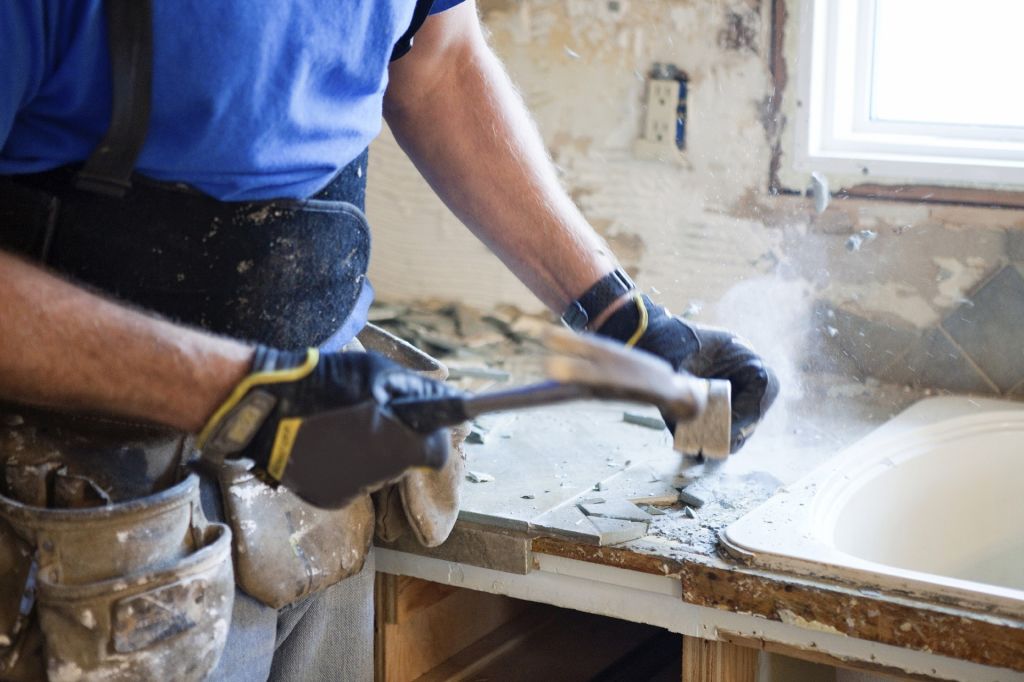Find the best kitchen renovation trade and professional help

The ease of your kitchen renovation and the quality of the outcome will be significantly impacted by the trade professionals you engage.
Domain research shows that 61 per cent of kitchen renovators use professional services, while another 21 per cent use a combination of DIY and trade assistance and only 18 per cent undertake a DIY renovation.
We all know a home renovation can be trying– it’s hard adjusting to a worksite in the middle of your house! But with the right help and a ‘can do’attitude it can be an exciting project for all.
Design and manufacture
You can engage a professional kitchen designer, kitchen manufacturer, interior designer or architect to design and manage the installation. Alternatively, after having the plans drawn up, you might engage a contractor (builder, cabinet-maker or kitchen manufacturer) to manage the installation and tradies. But there are some hardened renovators who undertake the project management themselves.
The introduction of flat-pack kitchens and 3D modelling has allowed some mass kitchen manufacturers to provide customers with a combination of services– renovators can either undertake the project themselves, manage part of it or ask a professional to do it for them. Managing all or part of the project yourself will be a big investment of your time and, depending on the scale of your renovation, you might need a licensed professional –it is important to check your local legislation.
Structural changes require building approval from your local council and the services of a licensed architect and builder.
“Approvals are generally required if major structural work or service [utility] changes are undertaken,”says Alex Milne, Executive Director of the Kitchen and Bathroom Designers Institute (KBDi). “This varies from state to state and differs between local authorities. Asbestos must be removed by a person licensed to undertake this activity.”
Your architect or builder can advise if you need to engage a structural engineer.
Professional services to consider:
- Architect
- Interior designer or interior architect
- Kitchen designer – refer to the KBDi website
- Kitchen manufacturer.
Building and carpentry
Wilhelm Harnisch, Chief Executive of Master Builders Australia, says consumers should find out what sort of work a builder or cabinetmaker usually undertakes.
“It is very important to understand that there are some builders who are more experienced in renovation than others [some focus mostly on new builds] and that these are very different exercises,”says Harnisch. “A new home builder is less used to the very personal and passionate specifications, and also the consultations, that take place from beginning to end between client and builder in a renovation situation,” he says.
When choosing a building contractor or cabinetmaker, you need to make sure they have the correct building licences and insurance.
You should get several quotes before settling on a contractor. It is important to read the fine print on the contract, review the contractor’s previous jobs, and obtain personal referrals. If you use a member of a building association you will gain peace of mind.
- Master Builders Australia – A member of Master Builders Australia will have the correct accreditation, licences and insurance and must abide by the association’s code of ethics and high professional standards. If you have a problem during your renovation or build, Master Builders Australia can assist you in dealing with the matter.
- Housing Industry Association (HIA) – This is a national association for the building industry. Members must abide by the association’s code of ethics and high building industry standards and will be up to date on the latest building regulations and requirements.
Harnisch emphasises the importance of getting references and a list of all inclusions. “This is where communicating with the builder and appointing the builder before you draw up formal plans or apply for permits is very important. The builder and client need to understand and include a list of all inclusions –what cabinets, benches, benchtops etc. are needed,”he says.
“Are the connections for imported taps etc. included? This is important when a passionate renovator has sourced or wants to import say taps direct from Italy. They may not be adapted to fit the sink.”
Electrical
Whoever is managing the installation, an electrician should be consulted once the layout is agreed upon. It helps to talk through any customisations, such as specialty lighting, changes in fixed appliances or major layout changes.
“There may be extra circuits needed to be run or substantial cabling works, which could add to the price. It’s better to be forewarned rather than get a ‘bill shock’near the end of the process,” says Master Electrician Chris Lehmann.
A licensed electrical contractor is the only person qualified to disconnect fixed appliances and power before demolition begins, and to reconnect newly installed fixed appliances.
According to Lehmann, a basic disconnect and reconnect in the same location, involving two to three visits and four or five basic switch plates, may cost as little as $350–$500. A major project with a large amount of customisation can cost a lot more. “In the most expensive kitchen project I have been involved with the electrical component [not appliances] was over $5000,”says Lehmann.
When looking for an electrician, he suggests getting referrals from friends or other tradies or contacting Master Electricians Australia to find an accredited Master Electrician in your area. “If someone is prepared to adhere to a safety and quality program like Master Electricians, with regular auditing and skills maintenance, then they are probably a safe bet.”
Plumbing
According to Master Plumber Dave Moyle, homeowners should talk to a plumber at the start of their planning process so that they are aware of the latest water regulations and standards, and the time, space and cost requirements involved in their desired layout, appliance and design ideas.
“The bigger the job, the earlier you should call your plumber. It is important, early in the renovation, to understand what can be achieved. Often services may not be easily accessible and simple to move,”explains Moyle. “Moving the sink closer to the fridge and swapping the gas stove with the dishwasher may look great, however, the work involved in moving all the services to achieve the new layout will be expensive.”
Only a licensed and registered plumber can undertake plumbing work, which is defined by eight main classes and six specialised classes. Always check your trade professional’s credentials with your local building authority and it is vital that you use a qualified gas installer as it is extremely dangerous work.
“All gas and below-ground sewerage works must have a certificate of compliance handed to the owner and be lodged with the Victorian Building Authority [VBA] [or your local building authority], no matter what the cost of the work. Any other work over $750, including labour and materials, requires a certificate of compliance to be lodged with the VBA,”says Moyle.
You will need a licensed plumber to disconnect fixed appliances and seal or alter pipework prior to other trade work and to reconnect the fixed appliances during the installation.
“It is best for a plumber to come in and carry out their installation first. It is easier to pull a wire through [a wall] than pull a pipe,”says Moyle. “To ensure the best outcome for the homeowner, it is important that the electrician and plumber communicate and work together.”
A Master Plumber is bound by a code of ethics, has undertaken extensive training, is licensed, registered and insured for six years.
Other trade professionals you may need to engage include plasterers, painters, flooring specialists and tilers. Remember, to find the right contractor you should obtain multiple quotes, check accreditation and insurance and seek referrals where possible.
Continue reading the Complete Kitchen Renovation Guide with: Choosing the optimal kitchen layout and style
We recommend
We thought you might like
States
Capital Cities
Capital Cities - Rentals
Popular Areas
Allhomes
More







